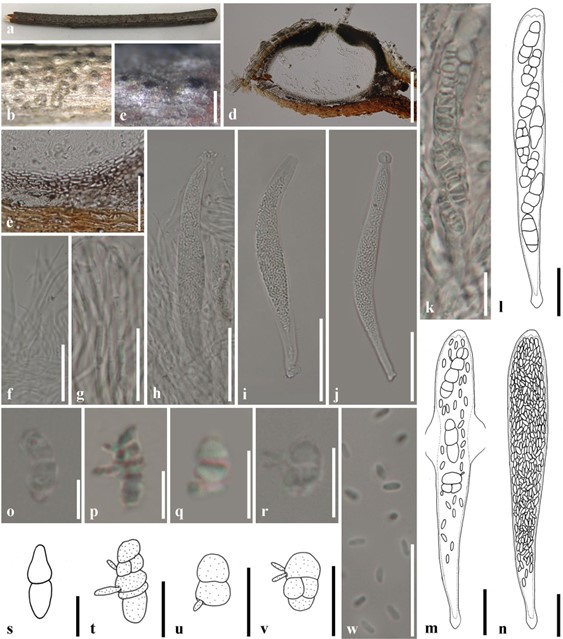Conidiotheca tympanoides (M.E. Barr) Réblová & L. Mostert, Mycol. Res. 111(3): 305 (2007)
Basionym: Romellia tympanoides M.E. Barr, Mycologia 77(4): 561 (1985)
MycoBank number: MB 510228; Index Fungorum number: IF 510228, Facesoffungi number: FoF 10050; Fig. 66
Saprobic on wood. Sexual morph: Ascomata 250–455 × 350–550 µm (x̄ = 345 × 425 µm, n = 10), perithecial, solitary to scattered, papillate, immersed, erumpent through the bark of the host, dark brown to black, subglobose to broadly conical, ostiolate, with papilla, periphysate. Peridium 25–50 µm (x̄ = 35 µm, n = 30) wide, comprising two layers, outer layer composed of black to pale brown cells of textura angularis; inner layer composed of hyaline cells of textura prismatica. Paraphyses 2–3.5 µm wide (x̄ = 2.8 µm, n = 30), numerous, septate, tapering, longer than the asci. Asci (120–)150–180(–200) × 15–18(–25) µm (x̄ = 170 × 16 µm, n = 50), 8-spored, cylindrical to clavate, short pedicellate, apex obtuse, with J-apical ring. Ascospores (10–)13–20(–25) × 3.5–6.5 µm (x̄ = 18 × 5 µm, n = 50),
1–2-seriate, hyaline, ellipsoidal to subglobose, 0–1-septate, sometimes slightly curved when young, becoming fusiform, with transverse and longitudinal septa, constricted at septa, producing several lateral appendices as ascoconidia. Asco- conidia (2.5–)3–5(–6) × 1–2.5 µm (x̄ = 4 × 1.5 µm, n = 50), hyaline, allantoid to ellipsoidal, aseptate, smooth-walled, guttulate, filling the whole ascus and discharged through constricted apical ring. Asexual morph: Undetermined.
Material examined: USA, Massachusetts, Baptist Hill, Conway, 21 April 1969, M.E. Barr, on twigs of Prunus pennsylvanica (NY-00912076, holotype).
Known hosts and distribution: On decayed wood of Prunus pennsylvanica in the USA (type locality) (Réblová and Mostert 2007).
Notes: The monotypic Conidiotheca is typified by C. tympanoides (Réblová and Mostert 2007). The holotype NY00912076 is well preserved, but there are few complete asci, and production of ascoconidia is unclear. Therefore, the hand-drawing is provided for the asci (Fig. 66l–n) and the process of producing ascoconidia (Fig. 66s–v) based on Réblová and Mostert (2007).

Fig. 66 Conidiotheca tympanoides: a–k, o–r, w (NY-00912076, hol- otype); l–n (redrawn from Réblová and Mostert 2007); s–v (Drawn following observation by microscope). a Herbarium material. b Gre- garious ascomata. c Ascomata. d Ascoma in cross section. e Perid- ium. f, g Septate paraphyses. h Ascus with paraphyses. i, j Asco- conidia filling the whole ascus and discharged through constricted apical ring. k–n Ascospores gradually swollen in ascus and produc- ing large numbers of ascoconidia. o–v Immature to mature ascospores (p–r, t–v ascospores producing ascoconidia). w Ascoconidia. Scale bars: c = 500 µm, d = 200 µm, e–j = 50 µm, k–n, w = 20 µm, o–v = 10 µm
